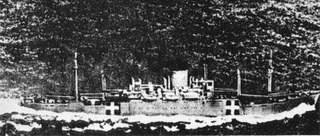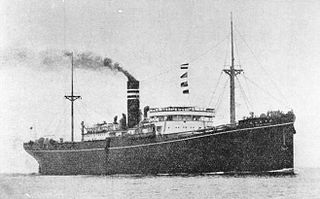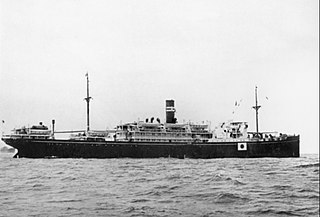 W
WAikoku Maru (愛国丸) was an armed merchant cruiser of the Imperial Japanese Navy in World War II. The ship entered service in 1940, the ship was later converted to an ammunition ship. She was sunk in February 1944 during Operation Hailstone.
 W
WAkikaze was a Minekaze-class destroyer, built for the Imperial Japanese Navy immediately following the end of World War I. The Minekaze class of destroyers were considered advanced for their time; these ships served as first-line destroyers through the 1930s. The class was considered obsolete by the start of the Pacific War and served in a number of roles including minesweeper, aircraft rescue ships and Kaiten-carriers.
 W
WArisan Maru was a 6,886 GRT Type 2A freighter constructed in 1944 during World War II and was one of Imperial Japan's hell ships. The vessel, named for a mountain on Formosa, was initially used as a troop transport. The vessel was then turned over for use for the transportation of prisoners of war (POWs) from the Philippines to Manchuria, China or Japan. On October 24, 1944 the ship was torpedoed by an American submarine and sank. Of the 1,781 POWs aboard, all of them escaped the sinking ship but were not rescued by the Japanese. In the end, only nine of the prisoners survived the sinking.
 W
WAsama Maru was a Japanese ocean liner owned by Nippon Yusen Kaisha (NYK). The ship was built in 1927–1929 by Mitsubishi Shipbuilding & Engineering Co. at Nagasaki, Japan. The vessel was named after an important Shinto shrine.
 W
WThe Awa Maru (阿波丸) was a Japanese ocean liner owned by Nippon Yusen Kaisha. The ship was built in 1941–1943 by Mitsubishi Shipbuilding & Engineering Co. at Nagasaki, Japan. The vessel was designed for passenger service, but the onset of war by the time work was completed changed requirements, and she was requisitioned by the Japanese Navy. While sailing as a relief ship under Red Cross auspices in 1945, she was torpedoed by USS Queenfish (SS-393), killing all but one of 2,004 people aboard.
 W
WThe Chichibu Maru (秩父丸) was a Japanese passenger ship which, renamed Kamakura Maru, was sunk during World War II, killing 2,035 soldiers and civilians on board.
 W
WSS De Klerk was a Dutch passenger-cargo liner owned by NV Koninklijke Paketvaart Mij (KPM) Batavia.
 W
WA hell ship is a ship with extremely inhumane living conditions or with a reputation for cruelty among the crew. It now generally refers to the ships used by the Imperial Japanese Navy and Imperial Japanese Army to transport Allied prisoners of war (POWs) and romushas out of the Dutch East Indies, the Philippines, Hong Kong and Singapore in World War II. These POWs were taken to the Japanese Islands, Formosa, Manchukuo, Korea, the Moluccas, Sumatra, Burma, or Siam to be used as forced labor.
 W
WThe Hofuku Maru, also known as Hohuku Maru was a Japanese Dai-ichi Taifuku Maru-class cargo ship, sunk on September 21, 1944 by American aircraft, while carrying 1,289 British and Dutch prisoners of war (POWs); 1,047 of them died.
 W
WJun'yō Maru (順陽丸) was a Japanese cargo ship that was attacked and sunk in 1944 by the submarine HMS Tradewind, resulting in the loss of over 5,000 lives.
 W
WSS Kachidoki Maru was a former US passenger ship, built in 1920 and captured by the Japanese in 1941. The ship was torpedoed on 12 September 1944, carrying 950 Allied prisoners of war of which 431 were killed.
 W
WLisbon Maru (りすぼん丸) was a Japanese cargo liner built at Yokohama in 1920 for a Japanese shipping line. During World War II, the ship became an armed troopship. On her final voyage, Lisbon Maru was being used to transport prisoners-of-war between Hong Kong and Japan when it was torpedoed on 1 October 1942, sinking with a loss of over 800 British lives.
 W
WMontevideo Maru was a Japanese auxiliary ship that was sunk in World War II, resulting in the drowning of many Australian prisoners of war and civilians being transported from Rabaul, in what is considered the worst maritime disaster in Australia's history. Prior to the war the ship operated as a passenger and cargo vessel traveling mainly between Asia and South America.
 W
WThe SS Op ten Noort was a luxury Passenger ship built by Nederlandsche Scheepsbouw Maatschappij in Amsterdam, Netherlands and completed in 1927. The ship was built for and owned by Koninklijke Paketvaart-Maatschappij. Op ten Noort means Up North. In December of 1941 she became a Royal Netherlands Navy hospital ship. Shortly after her conversion the Empire of Japan stole the ship and renamed her Tenno Maru. To cover up the war crimes against the ship and her medical crew, at the end of the war, she was sunk on August 17, 1945. Before sinking her, she was again renamed to Hikawa Maru No.2, after the Hikawa Shrine, Saitama.
 W
WŌryoku Maru was a Japanese passenger cargo ship which was commissioned by the Imperial Japanese Navy during World War II as a troop transport and prisoner of war (POW) transport ship. Japanese POW transport ships are often referred to as hell ships, due to their notoriously unpleasant conditions and the many deaths that occurred on board. In December 1944, the ship was bombed by American aircraft, killing 200 Allied POWs. Hundreds more died in the months that followed.
 W
WSS Teiryu Maru was a steam cargo ship that was launched in England in 1914 as Northwestern Miller. Furness, Withy & Co managed her until 1927, when Norddeutscher Lloyd bought her and renamed her Augsburg.
 W
WThe Tōfuku Maru (東福丸) was a Japanese Dai-ichi Taifuku Maru-class built and operated cargo ship and hellship.
 W
WThe Yoshida Maru (吉田丸) was a Japanese cargo ship owned by Nippon Yusen Kaisha. The ship was built in 1941 by Hakodate Dock at Hakodate on the northern island of Hokkaidō.